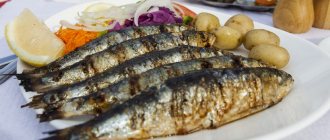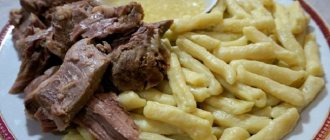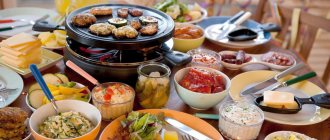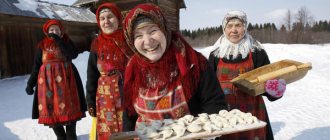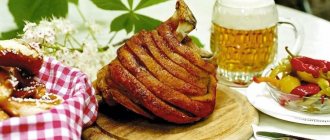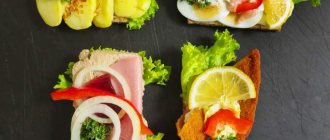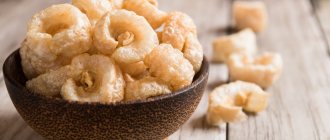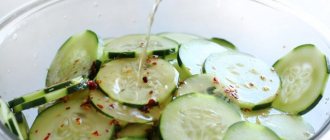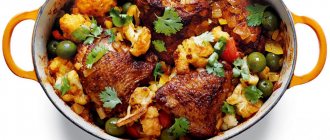Norwegian cuisine dates back to the Viking Age. Local residents prepare fish and other dishes according to ancient recipes.
In the harsh northern country of the fjords they love cheeses, dishes with meat and potatoes, and baked goods.
A trip to the country should be combined with an acquaintance with the national cuisine. It is useful to have in mind the 10 most delicious dishes of Norwegian cuisine.
Norwegian Jarlsberg cheese
Herring in apples
Salads and all kinds of Norwegian snacks are filling and rarely do without your favorite herring. Peel two small herrings and cut into small pieces. Cut 1 head of red onion into half rings. Chop a couple of medium apples and 1 pickled cucumber. Combine all the ingredients in a salad bowl and season them with 2 tbsp sauce. l. vegetable oil, 1 tbsp. l. mustard and 1 tsp. 3% vinegar. To finish, decorate the dish with slices of boiled eggs and herbs. By the way, for a festive family dinner you can serve this salad in the form of tartines.
Home Recipes
Norwegians do not deny themselves experiments in cooking. For a long time they have been using many of the world's popular products and seasonings, which add variety to everyday home dishes.
Pasta casserole with fish
Products:
- fresh or defrosted white fish fillet – 600 g;
- feather pasta – 300 g;
- milk – 2 tbsp.;
- eggs – 3 pcs.;
- butter – 50 g;
- flour – 2 tbsp. l.;
- breadcrumbs - 3 tbsp. l.;
- greens for decoration;
- salt, ground black pepper to taste;
- nutmeg – ½ tsp.
Pasta casserole with fish is a simple but very tasty dish of Norwegian cuisine.
Step-by-step preparation:
- Boil pasta until medium cooked.
- The fish is skinned and the bones are removed. Boil for 15-20 minutes, cool and separate into small pieces by hand.
- Grease a baking dish suitable for baking in the oven.
- Pasta and fish are mixed, salted and peppered.
- Melt butter in a frying pan, add flour and fry until golden brown.
- Add nutmeg and pour in half the milk. Cook until thickened.
- The yolks are separated from the whites, mixed with the rest of the milk and added to the sauce, stirring constantly.
- Pour the mixture evenly over the pasta.
- Beat the whites into a strong foam and spread over the surface of the mold, cover with breadcrumbs.
- Place in an oven preheated to 200°C for 40 minutes.
When the casserole has cooled, decorate with herbs and serve warm.
Country salad with herring
Products:
- lightly salted herring – 3 pcs.;
- apple – 1 pc.;
- onion – 1 pc.;
- sweet pepper – 1 pc.;
- hard-boiled yolk – 2 pcs.;
- large tomato – 1 pc.;
- corn grains – 100 g;
- sour cream – 2 tbsp. l.;
- lettuce leaves.
For the sauce:
- wine vinegar - 1 tbsp. l.;
- sunflower oil – 1 tbsp. l.;
- sour cream – 3 tbsp. l.;
- water – 100 ml;
- salt.
Preparation:
- The fish fillets are rinsed under water and cut into small pieces.
- Beat sour cream with a spoonful of water and pour it over the herring for 30 minutes.
- Peel and cut into cubes apples, onions, peppers, tomatoes. Lettuce leaves are torn by hand.
- The ingredients are mixed in a bowl, the yolk and corn are added.
- For the sauce, whisk all the ingredients and pour the dressing into the salad.
Christmas cookies with protein glaze
Compound:
- flour – 200 g;
- eggs – 3 pcs.;
- butter – 100 g;
- vanillin - to taste;
- powdered sugar – 2 tbsp. l.
Preparation:
- 1 hard-boiled egg and cool. The yolk is ground into crumbs.
- Beat soft butter and sugar for a few minutes. Add raw yolks and stir again until smooth.
- Add flour, vanillin and knead the dough to a dense but soft texture.
- Pinch off a small piece and form a ball.
- Beat raw whites until a layer of foam forms. One by one, dip the balls into it and roll in powdered sugar.
- Place on a baking sheet and bake at 180° C for 25 minutes.
The finished cookies have a golden color with a glossy sheen. Cool for 2-3 hours before serving. As a gift, it is given in a tin or paper box.
[media=
https://youtu.be/GA5p2SCWKKA
]
Brutal cheese
Speaking of snacks, we cannot fail to mention the famous Norwegian Brunost cheese. To prepare it, take 1.5 liters of fresh curd whey. If it is old, the cheese will turn out sour. Boil the whey to 500 ml, stirring continuously with a wooden spatula. Add 250 ml of heavy cream, 2 tbsp. l. butter and cook until thick. The mass should turn brown. The longer we simmer it, the richer the color will be. Beat the cheese mass with a blender, fill the silicone molds with it and put it in the refrigerator. The cheese will be hard but pliable. We cut it into thin slices, put it on crispy bread and treat it to our loved ones.
What products to please your loved ones when coming from Norway
For foreigners, the opportunity to taste authentic Norwegian products only appears within the country. They take home a lot of edible souvenirs:
- Brunost and other hard and soft cheeses.
- Klipfisk - salted dry cod.
- Sea fish caviar in tubes with varying degrees of smoking.
- Herring, cod, mackerel, salmon, sardines, fresh in vacuum packaging, in marinade, dried with spices, in cans.
- Raw salmon with horseradish gravet laks.
- Dry and raw smoked sausages from deer, elk, horse meat.
- Cloudberry, blueberry, cranberry jam.
- Chocolate “Kwik” and other products from the Freya factory.
- Salty-sweet candies “Lacris”.
- Vodka Linier - “Aquavit”.
- Herbal liqueur “Valhalla”.
Northern salmon
Norwegian salmon is eaten in any form in its homeland. We suggest preparing gravlax - marinated lightly salted salmon. Cut fillet weighing 1 kg in half, grease with 2 tbsp. l. cognac and olive oil. Chop a bunch of dill, add lemon zest, black pepper to taste and 2 tbsp. l. sea salt. Place this mixture between two pieces of fillet and wrap in foil. Place this “sandwich” under a press in the refrigerator for 12 hours. Then we swap the pieces of fish and marinate for another 12 hours. Blot the finished salmon with a napkin and cut into slices. To give gourmets a special treat, serve the sauce with 2 tbsp. l. Dijon mustard, 1 tsp. sugar, 2 tbsp. l. oil and 1 tsp. wine vinegar.
Kjotkaker – beef meatballs
The main competitor of the famous Swedish meatballs is the Norwegian dish kjotkaker. Norwegian meatballs are very similar to Swedish ones in both appearance and taste. The only difference between Kjotkaker and Ikea meatballs is that the Norwegians add more seasoning to the minced meat. In addition, Norwegian meatballs are not necessarily round, but their size can please even the hungriest eaters.
Captivating salmon
Another fish hit is Norwegian salmon soup. We make the usual frying from an onion and medium carrots. Scald 4 tomatoes with boiling water, remove the skin, cut the pulp into cubes and add to the frying. Simmer the vegetables for 3 minutes, fill them with 1⅓ liters of water and add 4 diced potatoes. The mixture should boil for 10 minutes, after which you can add 400 g of salmon, also cut into cubes. Next, pour in 500 ml of heated 20% cream and cook the soup for another 5 minutes. All that remains is to sprinkle it with chopped dill and let it brew under the lid for 20 minutes. You don’t have to invite your household members to the table - they will be brought in by the unique aroma.
Fruits and desserts
In cold climates, fruits and berries ripen slowly. As a result, they are smaller in size and have a richer flavor. Strawberries, blueberries, lingonberries, raspberries and apples are popular and part of many desserts, as are cherries in the parts of the country where they are grown. Wild cloudberries are considered a delicacy. A typical Norwegian dessert for special occasions is cloudberries with whipped or plain cream. Strawberry apple pie is also popular because of its rich flavor. Rhubarb pie ( rabarbrapai
in Norwegian) is another favorite dish in Norway.
German and Scandinavian style cakes and pastries such as sponges and Danish cookies (known as wienerbrød
, literal translation: "Viennese bread") share the table with a variety of homemade cakes, waffles and cookies.
Cardamom is a common flavoring. Another Norwegian cake is Krumkake, a tissue paper roll filled with whipped cream. (Kramkake means "Curved Cake" or "Crooked Cake"). Baked meringues are known as pikkiss
, which literally translates to "girl's kiss".
During Christmas ( July
), a traditional Norwegian holiday season, serves many different dessert dishes, including Julekake, a strongly spiced sourdough often coated with sugar and cinnamon, and Multikrem (clouded cream with cloudberries).
Sailor's Joy
Despite the boundless love of Scandinavians for Norwegian fish, meat dishes did not go unnoticed. A striking example of this is siemansbiff, also known as naval meat. Cut beef pulp weighing 400 g into portions, beat, coat with mustard and fry on both sides. Brown 2 onions in half rings and 4 potatoes in cubes in 90 g of bacon. Place the beef on the bottom of clay pots and cover with vegetables. Don't forget to season each layer with salt and pepper. Pour 400 ml of meat broth into the filling, cover the pots with lids and simmer for 30 minutes. In this form we will serve the meat to the table to the delight of home meat eaters.
Features of national Norwegian dishes
We can say that Norway has made a culinary revolution, thanks to which today local residents are proud of their national culinary traditions. Of course, the main diet of Norwegians is fish and seafood dishes. However, be prepared for the fact that the taste of herring in Norway is unusually sweet.
The attitude towards food in the country is simple - it is a way to get energy. However, special attention is paid to the quality and composition of products, often without paying attention to culinary delights. Norway is one of the few countries, and perhaps the only one, where oatmeal with sour cream is served as a delicacy on the holiday table.
The culinary revolution occurred primarily due to the rapid economic growth in Norway and the well-being of its inhabitants. Environmentally friendly products have become an absolute advantage.
The essence of Norwegian national cuisine lies in the peculiarities of farming. All pastures for grazing goats and sheep are located far from cities and are located in ecologically clean areas. Climatic conditions and fairly low temperatures make it possible to grow food without the use of pesticides. Farms operate under strict laws that regulate livestock farming. And, of course, the pride of Norwegians is the seas and oceans that wash the country’s shores and are rich in fish and seafood.
The country regularly hosts culinary festivals, where you can appreciate the entire palette of tastes from different regions of Norway. Most popular festivals:
- Glamat;
- Gusto;
- Tröndeshk.
Good to know! In stores, most of the products are locally produced, primarily cheeses, dairy products, baked goods and meats. Beer is produced in local breweries.
Related article: What souvenirs to bring from Norway?
Lamb in the bush
Lamb often appears in Norwegian recipes. One of the signature dishes is lamb with cabbage. Coarsely chop 500 g of meat (if the meat is on the bone, then use it together), fry until golden brown in butter, pour in ½ cup of water, salt and pepper, simmer until almost done. Take out the meat and simmer 1 kg of coarsely shredded cabbage in the same frying pan. Then we transfer it with the lamb into a heat-resistant form. Mix the juice in a frying pan with 40 g of flour, add a pinch of salt and pepper. Simmer the sauce until thick and pour it over the lamb and cabbage. Bake the dish for 20 minutes at 180°C. For the hungriest members of your household, you can supplement it with boiled potatoes.
Review
Lefse with rakfisk, onion rings and sour cream
Norwegian cuisine originates mainly from the dishes of peasants and fishermen and is largely influenced by the Scandinavian climate with short summers and long winters. Growing cereals is possible only in the southern part of the country, while only oats and barley grow here. These grains are not suitable for yeast dough, so thin, hard flatbrød breads are typical in Norway and can be stored for quite a long time. If potato mass is added to the dough, the flatbread becomes softer, similar to pita bread. This bread is called lefse. Currently the most popular breads are kneippbrød, named after Sebastian Kneipp, and franskbrød, white “French bread”.
Fishing is of great importance - fish and seafood are the most important component of Norwegian cuisine. Herring has long been the staple food of the Norwegian population, with the poor eating it four times a day for every meal. At the same time, the herring was salted, pickled, dried and fermented. Due to its long shelf life, dried klipfisk fish was popular. In the Middle Ages, a traditional dish, lutefisk, which is still traditional today, arose, which is dried fish soaked in an alkaline solution and then soaked in water.
The importation of potatoes into the country in the mid-18th century was of great importance for Norwegian cuisine. It is served both as a side dish for meat and separately for potato dishes. Porridge and other cereal dishes are also popular.
To replenish supplies for the winter, canning food was especially important, so many foods were dried, pickled, salted and smoked.
The modern Norwegian breakfast is quite hearty and more reminiscent of an English breakfast than a continental one. Lunch is snack-style and often consists of cold sandwiches (smørrebrød). The main meal is dinner, which will take place at 17-18 hours. Sometimes they also have a snack around 21.00, often coffee and cake.
Sweet intricacies
National dishes of Norway cannot be imagined without cinnamon buns. Mix 50 ml milk, 1 tsp. sugar, 1 tsp. yeast, let it rise. Separately combine 600 g of flour, 200 ml of milk, 80 g of sugar, egg and ½ tsp. ground cloves. Add the appropriate yeast, 60 g of butter into the mixture and knead the dough. For the filling, mix 60 g butter, 3 tbsp. l. sugar and 2 tbsp. l. cinnamon. Roll out the dough into a layer, grease half with the filling and cover with the other half. We cut the layer into strips of 3 cm, twist them into flagella and make something like knots. Place the buns on a baking sheet and bake for 20 minutes at 200°C. Complete the treat with berry juice, and the children will gobble it up in no time.
We hope that these dishes will please you and your loved ones, and some of them will add to your collection of favorite recipes. Bright delicious discoveries and bon appetit!
Tørrfisk - a fresh-dried variation of the usual dish
This unsalted, air-dried fish comes from the far north of Norway, the recipe for the national dish originates from the islands of Lofoten, Vesterålen. The dish has been considered a delicacy since the 12th century. As a rule, cod is used as a base, but recipes using pollock and haddock are known.
The cold drying method is one of the oldest methods of preserving the product, providing a long shelf life of up to several years. Special bacteria that can survive freezing temperatures are used to slowly preserve fish, giving it a richer flavor.
Aquavit
If you only have a few days left before departure, you should definitely try the AQUAVIT drink. This is a liqueur made with grass and potatoes. It contains 40 degrees of alcohol, so it is better not to try it in large quantities and observe moderation. You can always grab a bottle to share with friends when you return from your trip to Norway.
